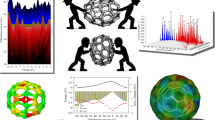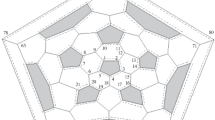Abstract
The static polarizability of the C60, C70, C80, and C186 fullerenes has been calculated within the semiempirical MNDO approximation implemented in the MOPAC quantum-chemical program package. It is demonstrated that the results obtained are comparable with experimental data and the results of the ab initio B3LYP method using the 6–31G(d, p) basis set. The influence of topological defects (five-, seven-, and eight-membered rings), vacancies produced by removing pentagons, and nitrogen and boron atoms on the geometric parameters and the polarizability of the C60, C240, and C540 fullerenes has been investigated by the MNDO method. It is revealed that the polarizability of the fullerene with topological defects is higher than the polarizability of the perfect icosahedral fullerene. The formation of vacancies in the carbon cage leads to a linear decrease in the polarizability of the fullerene and an increase in the specific polarizability. The polarizability of the heterofullerene with nitrogen or boron atoms spaced apart in the carbon cage is higher than that of the fullerene with heteroatoms located adjacent to each other.
Similar content being viewed by others
References
R. Antoine, P. Dugourd, D. Rayane, E. Benichou, M Broyer, F. Chandezon, and C. Guet, J. Chem. Phys. 110, 9771 (1999).
I. Compagnon, R. Antoine, M. Broyer, P. Dugourd, J. Lerme, and D. Rayane, Phys. Rev. A: At., Mol., Opt. Phys. 64, 025201 (2001).
S. Itoh, P. Ordejon, D. A. Drabold, and R. M. Martin, Phys. Rev. B: Condens. Matter 53, 2132 (1996).
V. L. Kuznetsov, A. L. Chuvilin, Yu. V. Butenko, I. Yu. Mal’kov, and V. M. Titov, Chem. Phys. Lett. 222, 343 (1994).
Z. M. Sheng and J. N. Wang, Carbon 44, 2089 (2006).
D. Ugarte, Carbon 33, 9 (1995).
K. R. Bates and G. E. Scuseria, Theor. Chem. Acc. 99, 29 (1998).
M. I. Heggie, M. Terrones, B. R. Eggen, G. Jungnickel, R. Jones, C. D. Latham, P. R. Briddon, and H. Terrones, Phys. Rev. B: Condens. Matter 57, 13339 (1998).
H. Terrones and M. Terrones, J. Phys. Chem. Solids 58, 1789 (1997).
C. He, N. Zhao, C. Shi, Z. Du, J. Li, L. Cui, and F. He, Scr. Mater. 54, 1739 (2006).
D. Jonsson, P. Norman, K. Ruud, H. Ågren, and T. Helgaker, J. Chem. Phys. 109, 572 (1998).
R.-H. Xie, G. W. Bryant, L. Jensen, J. Zhao, and V. H. Smith, J. Chem. Phys. 118, 8621 (2003).
Ph. Lambin, A. A. Lucas, and J.-P. Vigneron, Phys. Rev. B: Condens. Matter 46, 1794 (1992).
A. Mayer, Ph. Lambin, and R. Langlet, Appl. Phys. Lett. 89, 063117 (2006).
Yung Hang Hu and Eli Ruckenstein, J. Chem. Phys. 123, 214708 (2005).
G. K. Gueorguiev, J. M. Pacheco, and D. Tománek, Phys. Rev. Lett. 92, 215501 (2004).
M. J. S. Dewar and W. Thiel, J. Am. Chem. Soc. 99, 4899 (1977).
A. A. Vooetyuk, Zh. Strukt. Khim. 29, 138 (1988).
A. D. Becke, J. Chem. Phys. 98, 5648 (1993).
C. Lee, W. Yang, and R. G. Parr, Phys. Rev. B: Condens. Matter 37, 785 (1988).
P. Fuentealba, Phys. Rev. A: At., Mol., Opt. Phys. 58, 4232 (1998).
A. J. Stone and D. J. Wales, Chem. Phys. Lett. 128, 501 (1986).
R. Langlet, N. Geuquet, A. Mayer, L. Henrard, Ph. Lambin, M. Arab, F. Picaud, M. Devel, and C. Girardet, in Program and Book of Abstracts of the Joint International Conference “Nanocarbon and Nanodiamond 2006,” St. Petersburg, Russia, 2006 (St. Petersburg, 2006), p. 63.
Gun-Do Lee, C. Z. Wang, Eujioon Yoon, Nong-Moon Hwang, Doh-Yeon Kim, and K. M. Ho, Phys. Rev. Lett. 95, 205501 (2005).
A. V. Krasheninnikov, P. O. Lehtinen, A. S. Foster, and R. M. Nieminen, Chem. Phys. Lett. 418, 132 (2006).
Author information
Authors and Affiliations
Corresponding author
Additional information
Original Russian Text © O.V. Sedel’nikova, L.G. Bulusheva, A.V. Okotrub, 2009, published in Fizika Tverdogo Tela, 2009, Vol. 51, No. 4, pp. 815–821.
Rights and permissions
About this article
Cite this article
Sedel’nikova, O.V., Bulusheva, L.G. & Okotrub, A.V. Influence of defects in the carbon network on the static polarizability of fullerenes. Phys. Solid State 51, 863–869 (2009). https://doi.org/10.1134/S1063783409040404
Received:
Accepted:
Published:
Issue Date:
DOI: https://doi.org/10.1134/S1063783409040404




